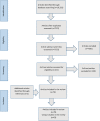A Systematic Review of Interventions to Change Staff Care Practices in Order to Improve Resident Outcomes in Nursing Homes
- PMID: 26559675
- PMCID: PMC4641718
- DOI: 10.1371/journal.pone.0140711
A Systematic Review of Interventions to Change Staff Care Practices in Order to Improve Resident Outcomes in Nursing Homes
Abstract
Background: We systematically reviewed interventions that attempted to change staff practice to improve long-term care resident outcomes.
Methods: Studies met criteria if they used a control group, included 6 or more nursing home units and quantitatively assessed staff behavior or resident outcomes. Intervention components were coded as including education material, training, audit and feedback, monitoring, champions, team meetings, policy or procedures and organizational restructure.
Results: Sixty-three unique studies were broadly grouped according to clinical domain-oral health (3 studies), hygiene and infection control (3 studies), nutrition (2 studies), nursing home acquired pneumonia (2 studies), depression (2 studies) appropriate prescribing (7 studies), reduction of physical restraints (3 studies), management of behavioral and psychological symptoms of dementia (6 studies), falls reduction and prevention (11 studies), quality improvement (9 studies), philosophy of care (10 studies) and other (5 studies). No single intervention component, combination of, or increased number of components was associated with greater likelihood of positive outcomes. Studies with positive outcomes for residents also tended to change staff behavior, however changing staff behavior did not necessarily improve resident outcomes. Studies targeting specific care tasks (e.g. oral care, physical restraints) were more likely to produce positive outcomes than those requiring global practice changes (e.g. care philosophy). Studies using intervention theories were more likely to be successful. Program logic was rarely articulated, so it was often unclear whether there was a coherent connection between the intervention components and measured outcomes. Many studies reported barriers relating to staff (e.g. turnover, high workload, attitudes) or organizational factors (e.g. funding, resources, logistics).
Conclusion: Changing staff practice in nursing homes is possible but complex. Interventionists should consider barriers and feasibility of program components to impact on each intended outcome.
Conflict of interest statement
Figures
Similar articles
-
Interventions for preventing and reducing the use of physical restraints for older people in all long-term care settings.Cochrane Database Syst Rev. 2023 Jul 28;7(7):CD007546. doi: 10.1002/14651858.CD007546.pub3. Cochrane Database Syst Rev. 2023. PMID: 37500094 Free PMC article.
-
Algorithm-based pain management for people with dementia in nursing homes.Cochrane Database Syst Rev. 2022 Apr 1;4(4):CD013339. doi: 10.1002/14651858.CD013339.pub2. Cochrane Database Syst Rev. 2022. PMID: 35363380 Free PMC article.
-
Sexual Harassment and Prevention Training.2024 Mar 29. In: StatPearls [Internet]. Treasure Island (FL): StatPearls Publishing; 2025 Jan–. 2024 Mar 29. In: StatPearls [Internet]. Treasure Island (FL): StatPearls Publishing; 2025 Jan–. PMID: 36508513 Free Books & Documents.
-
Interventions for preventing abuse in the elderly.Cochrane Database Syst Rev. 2016 Aug 16;2016(8):CD010321. doi: 10.1002/14651858.CD010321.pub2. Cochrane Database Syst Rev. 2016. PMID: 27528431 Free PMC article.
-
Home treatment for mental health problems: a systematic review.Health Technol Assess. 2001;5(15):1-139. doi: 10.3310/hta5150. Health Technol Assess. 2001. PMID: 11532236
Cited by
-
Evaluation of a Palliative Care Program for Nursing Homes in 7 Countries: The PACE Cluster-Randomized Clinical Trial.JAMA Intern Med. 2020 Feb 1;180(2):233-242. doi: 10.1001/jamainternmed.2019.5349. JAMA Intern Med. 2020. PMID: 31710345 Free PMC article. Clinical Trial.
-
Psychosocial interventions for reducing antipsychotic medication in care home residents.Cochrane Database Syst Rev. 2023 Aug 31;8(8):CD008634. doi: 10.1002/14651858.CD008634.pub3. Cochrane Database Syst Rev. 2023. PMID: 37650479 Free PMC article.
-
Implementation of a complex intervention to improve participation in older people with joint contractures living in nursing homes: a process evaluation of a cluster-randomised pilot trial.BMC Geriatr. 2020 Aug 5;20(1):270. doi: 10.1186/s12877-020-01655-z. BMC Geriatr. 2020. PMID: 32758147 Free PMC article.
-
A personhood and citizenship training workshop for care home staff to potentially increase wellbeing of residents with dementia: intervention development and feasibility testing of a cluster randomised controlled trial.Pilot Feasibility Stud. 2023 Jan 9;9(1):2. doi: 10.1186/s40814-022-01222-w. Pilot Feasibility Stud. 2023. PMID: 36624509 Free PMC article.
-
Implementation of a Stepwise, Multidisciplinary Intervention for Pain and Challenging Behaviour in Dementia (STA OP!): A Process Evaluation.Int J Integr Care. 2018 Sep 7;18(3):15. doi: 10.5334/ijic.3973. Int J Integr Care. 2018. PMID: 30220897 Free PMC article.
References
-
- Testad I, Corbett A, Aarsland D, Lexow KO, Fossey J, et al. (2014) The value of personalized psychosocial interventions to address behavioral and psychological symptoms in people with dementia living in care home settings: A systematic review. International Psychogeriatrics 26: 1083–1098. 10.1017/S1041610214000131 - DOI - PubMed
Publication types
MeSH terms
LinkOut - more resources
Full Text Sources
Other Literature Sources
Medical
Miscellaneous



